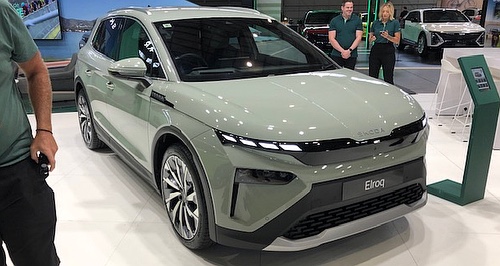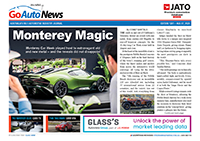Make / Model Search
News - Events - Everything Electric ExpoBumper BEV show in SydneyIncreased exhibitors, patrons suggest Sydney’s Everything Electric Expo was a success10 Mar 2025 BOOM, this year’s Everything Electric Expo (EEE) promoted by Fully Charged Show Limited out of Bristol UK was a bigger event compared to last year in both visitor numbers and exhibitors.
While the official number of patrons is yet to be confirmed, it was obvious from the opening on Friday March 7 that the expo had traction with electric vehicle aficionados who – judging by the 50-metre-long entry queue and a Boxing Day sales like rush to gain access at 10.00am – could have doubled in number year on year.
The EEE competes with the Sydney (and Melbourne) International EV AutoShow promoted by events company Future Drive Auto, which runs its Sydney expo in November, leaving five months between the two similarly-themed shows in the city.
Offering patrons more than a walk-around viewing of static exhibits, the Sydney EEE enables auto-makers and importers to run test drives of their vehicles directly out of the event precinct, which this year provided dozens of different brands and models available for the public to take for a supervised spin.
Show organisers predicted that 15,000-20,000 test drives would take place during the three days of the expo, a figure that seems almost impossible given the logistics involved.
However, an army of facilitators was on hand to usher potential buyers through the test drive process with cars selected from an expansive carpark of choices within the exhibition building.
Organisers said 35 OEMs were present at the 2025 Sydney EEE, among them a rash of new-to-Australia brands from China including Xpeng, Skywell, Geely, Deepal, Leapmotor, Farizon and Zeekr along with established Chinese brands BYD, Chery, GWM and MG.
All had dedicated stands with their model line-ups on display, some with new or unreleased vehicles exhibited for the first time in Australia.
Other OEMs with displays included brands of the giant Stellantis and Volkswagen Group conglomerates plus Cadillac, Ford, Kia, Renault, Polestar and Tesla, the latter with a throng of corporately attired helpers on hand to take orders for the facelifted Model Y that made its Australian debut during the event.
Mercedes-Benz and BMW Group had representations, while a rash of electric motorcycle, e-bike and scooter companies including Savic and Segway took the opportunity to show their wares, many of them new models.
Notable for their absence despite having electric cars in their line-ups were: Genesis, Hyundai, Jaguar, LDV, Lexus, Lotus, Nissan, Porsche, Rolls Royce, Subaru, Toyota and Volvo.
Cars occupied roughly half of the Sydney Showground venue with the other half filled with peripheral enterprises including numerous charger manufacturers and suppliers such as New Zealand outfit EVNEX and technology companies such as Janus which demonstrated its cassette-style battery pack for heavy transport vehicles.
During press presentations before the show opened, competition between the various exhibitors was palpable and especially among charging equipment suppliers with a standard assertion of 'priced less than existing chargers' ringing loud and clear from many.
There was even one display from Alspecsolar that featured a carport with its entire roof in solar panels designed for vehicle recharging. Another featured a new Toyota Landcruiser 70 series ute converted to electric, with numerous other conversions of classic cars elsewhere at the expo to check out.
A brand seen publicly for the first time Down Under during the Sydney EEE was Farizon, part of the Geely group, which pulled the covers off three vehicles: a fully electric 4.5 tonne light truck called the H9EE that has a claimed range of 352km and two electric vans called SV in short-wheelbase low roof and mid-wheelbase high roof formats.
The brand launches here in April through Jamil Motors which has dealerships focused in capital cities at the moment.
Of particular interest on the van was its capability to measure load weight and display it on the instrument cluster.
Though not a true electric vehicle, Ford used the expo to showcase an early production version of is incoming Ranger plug-in hybrid (PHEV) ute that is priced from $71,990 excluding on-road costs, some $14,000 more than competitor BYD asks for its Shark 6 PHEV one-tonner. A lone Mustang Mach E was poignantly positioned next to the Ranger PHEV.
Audi displayed its just-released Q6 E-Tron models while Skoda showed its new all-electric Enyaq and Elroq SUVs.
Some yet-to-be-released Chinese models had already broken cover at last November’s Melbourne International EV AutoShow, such as a clutch of sensational lookers from Zeekr including the Mix, the 009 and the 7X to name a few.
Xpeng whipped the covers off yet another medium SUV called the Mona Mo3 as Deepal did with its incoming E07 and S05, the former looking more attractive in the metal than images would suggest.
Considerable hoopla surrounded the debut of the new Tesla Model Y which, it must be said, is a cracking looking medium size SUV from the US giant but a first in-the-metal view of the big and ugly Cybertruck took our breath away.
Not to be overshadowed by anybody, Kia was out in force with a full array of its current and incoming BEVs including the new EV3 that is due to land in a few weeks.
Apart from the big uptick in patronage and exhibitors, two things stood out at the expo that provided a peek into the near future of the new car segment: The number of Chinese offerings flooding in and their styling similarity in many, but not all cases.
It should make for an interesting 2025.  Read more |
Click to shareEvents articlesResearch Events Motor industry news |












Facebook Twitter Instagram